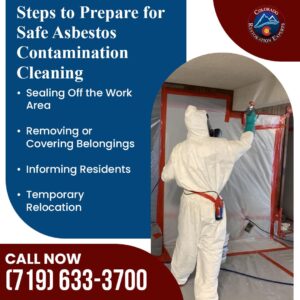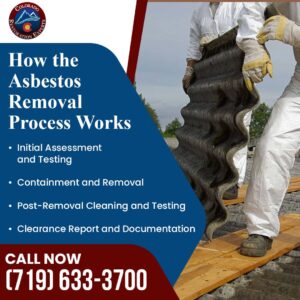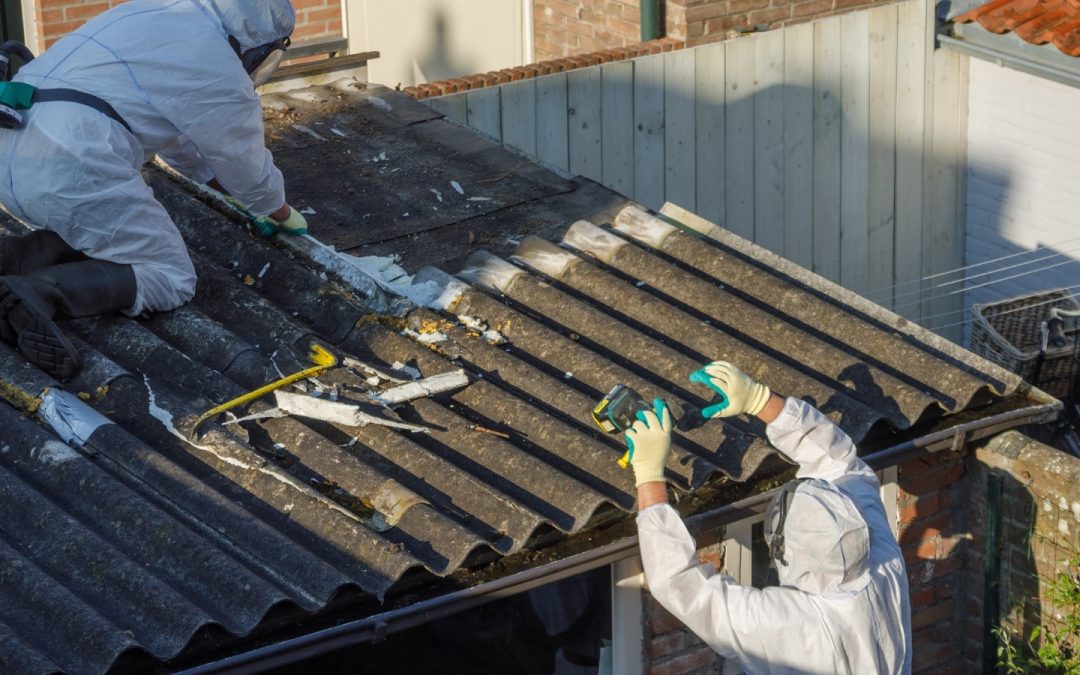Preparing your property for asbestos abatement requires careful planning and clear information to protect your home and family. At Colorado Restoration Experts, we understand the challenges homeowners face when dealing with asbestos contamination. Whether you’re renovating an older building or suspect hidden hazards, proper asbestos contamination cleaning is critical for safety and meeting regulatory standards.
This process involves more than just removing materials—it includes thorough testing, containment, and final clearance to confirm your living space is safe. Our team helps you prepare your property efficiently and confidently, reducing stress and avoiding costly errors.
Asbestos and Its Risks
Asbestos remains one of the most dangerous materials still present in older homes across Colorado. If you’re a homeowner considering renovations or repairs, knowing where asbestos may be hiding—and how it can affect your health—matters more than ever.
What is Asbestos?
Asbestos is a naturally occurring mineral once widely used in building materials for its durability and fire resistance. It was commonly applied in residential and commercial construction from the early 1900s through the late 1970s. You’ll often find it in older drywall, pipe insulation, roof shingles, floor tiles, and ceiling texture materials.
The microscopic fibers that makeup asbestos are nearly invisible to the naked eye. These fibers stay airborne for hours when disturbed and may linger in indoor environments long after the work is done. Even though asbestos was banned in many products by the late 1980s, the material remains present in millions of structures built before that time. If your house was built before 1980, there’s a real possibility that some materials inside it contain asbestos—even if the home has been remodeled over the years.

Health Concerns Related to Asbestos Exposure
Inhaling airborne asbestos fibers can cause serious respiratory illnesses and cancers. The risk increases with repeated exposure and is most severe for those who disturb asbestos without proper containment. Once the fibers are in your lungs, the body cannot easily remove them.
Long-term asbestos exposure is directly linked to diseases like asbestosis, a chronic lung condition, and mesothelioma, which is a rare cancer that forms in the lining of the lungs, chest, or abdomen. Lung cancer is also associated with long-term exposure, especially for individuals who smoke. These diseases don’t appear immediately—many people diagnosed with asbestos-related illnesses were exposed decades earlier.
There is no safe level of asbestos exposure. Even a small amount of airborne fiber can lead to serious consequences over time. That’s why any suspected asbestos disturbance must be addressed quickly and professionally.
Recognizing the Need for Asbestos Abatement
Before any renovation or demolition project, it’s important to understand if your property is at risk of asbestos exposure. Asbestos fibers are not visible to the naked eye, and by the time symptoms or damage appear, the risk has already been present for some time.
When Should You Consider Asbestos Testing?
Testing is necessary before any renovation, demolition, or HVAC work in buildings suspected to contain asbestos. If your home was constructed before federal asbestos restrictions began in the late 1970s, testing should be the initial step in your planning process. Asbestos has been used in insulation, ceiling tiles, adhesives, wallboard, and roofing materials for decades. Even if your house was built just after 1980, leftover materials or undocumented installations may still contain it. If you plan to remove flooring, walls, or insulation, professional testing confirms whether asbestos abatement is required to avoid exposing occupants to hazardous fibers.
Disturbing materials without testing exposes everyone in the building to airborne particles. A single home project can release thousands of microscopic fibers into the air. No amount of asbestos exposure is considered safe. That’s why Colorado law requires testing before starting construction activities on any suspect materials.
Signs of Asbestos Contamination
Visible damage to materials such as crumbling insulation, cracked tiles, or deteriorating drywall may indicate asbestos contamination. You might see peeling insulation or older vinyl tiles breaking apart. These are common sources of asbestos. Any signs of aging or damage to materials from the mid-20th century should be treated as potential risks until tested.
Unexplained respiratory symptoms among occupants or findings during routine property inspections can also suggest the presence of asbestos contamination. Chronic coughing, chest discomfort, or frequent respiratory infections in residents could be connected to airborne particles in the home. If an inspector flags possible asbestos or mentions it in a report, don’t wait—act before the risk spreads further.
Colorado Restoration Experts works with certified third-party testing companies and follows all required regulations under Colorado’s asbestos laws. Our goal is to protect you, your property, and everyone who steps inside.
Steps to Prepare Your Property Before Cleanup
Before asbestos removal can begin, there are a few important actions you need to take to get your home or building ready. These steps help reduce risks, protect belongings, and create a safe environment for the technicians performing the work.
Securing the Work Area
The area must be sealed off to prevent asbestos fibers from spreading during removal. This involves closing doors, sealing vents, and restricting access to authorized personnel.
Containment is critical because airborne asbestos particles are not visible and can easily spread to other areas. The technician will typically section off the space using thick plastic sheeting and industrial tape. All heating and cooling vents must be tightly sealed to keep fibers from circulating through the HVAC system.
Posting warning signs and using physical barriers helps maintain safety throughout the asbestos contamination cleaning process. Federal law under OSHA requires that warning signs be placed at all entry points to the work zone, clearly marking it as a hazardous area. This is not just for worker safety—it also alerts anyone in the vicinity to stay clear. At Colorado Restoration Experts, our team arrives prepared to secure every necessary boundary to keep your building safe throughout the job.
Removing or Protecting Personal Belongings
All personal items should be removed or securely covered to avoid contamination. Fragile and frequently used items need relocation outside the work zone. Anything left in the workspace is at risk of exposure to asbestos fibers. Even small fibers can cling to fabric, electronics, and porous materials, which can lead to further contamination if not handled properly.
Examples include furniture, electronics, clothing, and valuables, which can be damaged or contaminated if left exposed. Take special care with bedding, upholstered items, and family heirlooms. These should either be moved to another part of the home or stored outside the property during abatement. Anything that must remain in the space should be wrapped and sealed in plastic before work begins.
Informing Your Household or Tenants
Everyone in the building should be informed about the abatement schedule and safety precautions. You, your family, or any tenants need clear details about what the work involves, where it will take place, and how long it will last. This is especially important for shared spaces like apartment buildings or duplexes. Giving people enough time to prepare helps prevent misunderstandings and disruption.
Clear communication minimizes disruptions and helps occupants understand necessary restrictions or possible temporary relocation. Let them know about restricted areas and potential noise, and give updates if the timeline changes. Written notices or posted flyers near shared entrances help make the process smooth and respectful for everyone affected.
Arranging for Temporary Relocation if Necessary
Depending on the contamination extent, temporary relocation may be required to protect occupants during cleanup. If asbestos is present in common areas such as living rooms, kitchens, or ductwork, staying on the property during removal may not be safe. In some cases, even a single day of exposure in an active cleanup zone can pose long-term health risks.
Extensive asbestos contamination cleaning in living areas or HVAC systems often necessitates staying elsewhere until clearance tests confirm safety. Asbestos particles can remain airborne for up to 72 hours. That’s why third-party clearance testing is mandatory before anyone returns to the space. Our team at Colorado Restoration Experts handles abatement with a detailed cleanup and testing protocol, and we always notify property owners the moment clearance is confirmed.

What to Expect During the Asbestos Abatement Process
Asbestos abatement involves more than simply removing hazardous material. Each phase must follow strict guidelines to protect people, property, and air quality. If you’re preparing your home for this process, here’s what you can expect.
Initial Testing and Inspection
Certified inspectors perform thorough testing to identify asbestos types and contamination levels before work begins. This step starts with material sampling and air testing in areas suspected to contain asbestos. Inspectors typically take samples from drywall, insulation, flooring, and ceilings, especially in homes built before 1980. The testing identifies both friable (easily crumbled) and non-friable asbestos materials.
Sampling suspected materials and air quality measurements establish baseline conditions to guide removal procedures. The data collected during this phase helps determine how the removal will proceed and what protective measures need to be in place. It also helps define how extensive the cleanup needs to be. Exposure risk increases when asbestos is disturbed, especially during construction or remodeling. Early, accurate testing helps avoid unnecessary exposure and cost.
Containment and Removal Procedures
Licensed technicians isolate the area using plastic sheeting and negative air pressure systems to prevent fiber escape. Once asbestos is confirmed, technicians begin by sealing off the work zone. This means using polyethylene sheets, duct tape, and airtight barriers to keep airborne fibers from moving into other parts of your home. Negative pressure machines are also set up to keep contaminated air from escaping.
They carefully remove asbestos-containing materials following strict safety protocols that minimize disturbance and exposure. Only certified asbestos abatement professionals can remove these materials legally and safely. Workers wear full protective suits and respirators and use tools designed to limit the release of fibers into the air. The removal process often includes the use of wet methods to reduce dust. Every material taken out of your home is handled under controlled conditions and bagged in leak-tight containers for disposal at a licensed facility.
Cleaning and Air Quality Testing
After removal, HEPA vacuums and wet wiping clean all surfaces to capture residual fibers. Even with controlled removal, some fibers may remain in the area. Technicians use High-Efficiency Particulate Air (HEPA) vacuums to clean the air and surfaces, followed by thorough wiping using wet cleaning techniques. This step is repeated until visual inspections confirm cleanliness.
Independent air quality tests confirm that airborne asbestos levels meet safety standards before clearance. To move forward, the air inside the abatement area must meet safety levels defined by state and federal guidelines. In Colorado, these standards are detailed under Regulation 8, Part B. A third-party testing company, not affiliated with the abatement contractor, performs air quality sampling. Their results determine whether the space is ready for re-occupancy.
Final Clearance and Certification
Once tests confirm the space is safe, a clearance report is issued certifying successful asbestos abatement. You’ll receive a detailed report showing that the air quality meets regulatory standards and that the hazardous material was properly removed. This is not just paperwork—it can be essential when selling a home, submitting insurance claims, or working with lenders.
This documentation verifies compliance and is essential for future property sales or insurance purposes. Without certified clearance, many property transactions or occupancy permits could be delayed. It’s also a record that the job was handled according to legal and safety standards.
Colorado Restoration Experts follows each of these steps with precision, using licensed professionals and third-party testing to carry out every asbestos abatement project by Colorado’s legal framework. Our process is detailed, methodical, and built around protecting your home and the people in it.
Why Choose Colorado Restoration Experts for Your Asbestos Abatement Needs
Here’s why many property owners across Colorado trust our team to manage every stage of asbestos contamination cleaning with professionalism and accuracy.
Extensive Experience and Trusted Reputation
Colorado Restoration Experts bring over 20 years of experience in asbestos removal across the front range, serving Colorado Springs, Pueblo, Castle Rock, Woodland Park, and Denver areas. With more than 100 completed projects and a strong record of first-pass clearance results, we handle each job with precision. Our team works thoroughly—never cutting corners—and has earned the trust of homeowners, inspectors, and agencies statewide by delivering consistent, high-quality asbestos abatement for both residential and commercial properties.
Transparent, Line-Item Estimates
Colorado Restoration Experts provide clear, line-item estimates that outline every service and cost involved. We identify only the areas with actual asbestos contamination, helping you avoid unnecessary work. This approach has saved many homeowners thousands of dollars. Unlike vague lump-sum quotes, our estimates prevent surprise charges and keep your project transparent from start to finish. You get accurate pricing and only pay for the work truly needed.
Strict Compliance with Colorado Regulations
Colorado Restoration Experts follow Regulation 8, Part B, along with all federal asbestos removal guidelines. We manage every step—containment, removal, transport, and certified disposal—with strict adherence to legal standards. Third-party clearance testing is completed on every project. This testing confirms that the site is safe before reentry. We do not cut corners and follow all mandated procedures to protect both people and the environment.
Complete Support from Inspection to Reconstruction
Beyond asbestos removal, Colorado Restoration Experts also provides full reconstruction services, including drywall repair, flooring installation, and painting. Once asbestos contamination cleaning is completed, properties often need repairs to return to safe, usable condition. Rather than hiring multiple contractors, you can rely on our team to handle everything—rebuilding walls, replacing flooring, and restoring affected areas. This keeps your project on track, reduces delays, and gives you a consistent process from start to finish under one experienced team.
Contact Colorado Restoration Experts for Safe Asbestos Abatement
If you’re planning a renovation, dealing with damaged materials, or concerned about possible asbestos contamination, now is the time to act. Colorado Restoration Experts, based in Colorado Springs, CO, provides licensed asbestos abatement for homes and businesses. Our experienced team works with third-party testers, follows Colorado regulations, and delivers accurate line-item estimates you can trust.
Call (719) 633-3700 or email us at tim@coloradorestore.com to schedule your asbestos inspection or removal service today.


Recent Comments